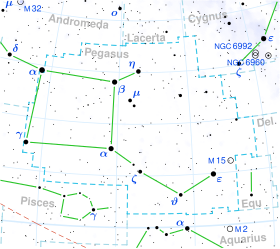Iota Pegasi
Star in the constellation Pegasus From Wikipedia, the free encyclopedia
ι Pegasi, Latinized as Iota Pegasi is a double-lined spectroscopic binary[8] star system located within the northern constellation of Pegasus, along a line between Lambda and Kappa Pegasi. It is visible to the naked eye as a yellow-hued point of light with a combined apparent visual magnitude of 3.77.[2] The system is located 38.5 light years from the Sun based on parallax,[1] but is drifting closer with a radial velocity of −5.5 km/s.[5]
| Observation data Epoch J2000.0 Equinox J2000.0 | |
|---|---|
| Constellation | Pegasus |
| Right ascension | 22h 07m 00.66206s[1] |
| Declination | 25° 20′ 42.3761″[1] |
| Apparent magnitude (V) | 3.77[2] (3.84 + 6.68)[3] |
| Characteristics | |
| Spectral type | F5V + G8V[4] |
| Astrometry | |
| Radial velocity (Rv) | −5.5±0.7[5] km/s |
| Proper motion (μ) | RA: 298.420[1] mas/yr Dec.: 26.161[1] mas/yr |
| Parallax (π) | 84.7637 ± 0.3596 mas[1] |
| Distance | 38.5 ± 0.2 ly (11.80 ± 0.05 pc) |
| Absolute magnitude (MV) | 3.42[2] (3.49 + 6.33)[3] |
| Orbit[4] | |
| Companion | Iota Pegasi B |
| Period (P) | 10.2130253(16) d |
| Semi-major axis (a) | 10.329(16) mas |
| Eccentricity (e) | 0.001764(63) |
| Inclination (i) | 95.83(12)° |
| Longitude of the node (Ω) | 176.262(75)° |
| Periastron epoch (T) | 52997.378(52) |
| Argument of periastron (ω) (secondary) | 272.8(1.8)° |
| Semi-amplitude (K1) (primary) | 48.4757(39) km/s |
| Semi-amplitude (K2) (secondary) | 77.777(16) km/s |
| Details | |
| ι Peg Aa | |
| Mass | 1.33[3] M☉ |
| Radius | 1.526 ± 0.068[6] R☉ |
| Surface gravity (log g) | 4.26[3] cgs |
| Temperature | 6,580[3] K |
| Age | 4−663[4] Myr |
| ι Peg Ab | |
| Mass | 0.82[3] M☉ |
| Radius | 0.73[3] R☉ |
| Surface gravity (log g) | 4.62[3] cgs |
| Temperature | 5,060[3] K |
| Other designations | |
| Database references | |
| SIMBAD | data |
The binary nature of this system was discovered by W. W. Campbell in 1899 and the initial orbital elements were estimated by H. D. Curtis in 1904.[8] The primary, designated component Aa, is a yellowish-white star somewhat brighter than the sun. It and the dimmer component Ab orbit each other with a period of about 10 days and an eccentricity of almost zero, meaning they essentially have a circular orbit.[4] They appear to be very young stars, close to zero-age main sequence.[8]
In about four billion years from now, component Aa will evolve off the main sequence into a giant. In the process it will overflow its Roche lobe and begin to transfer mass onto the secondary. This may cause the secondary to acquire enough mass to become the primary component. After both stars have passed through the giant star stage, the end result will be a pair of co-orbiting white dwarfs in about eight billion years.[3]
References
External links
Wikiwand - on
Seamless Wikipedia browsing. On steroids.

